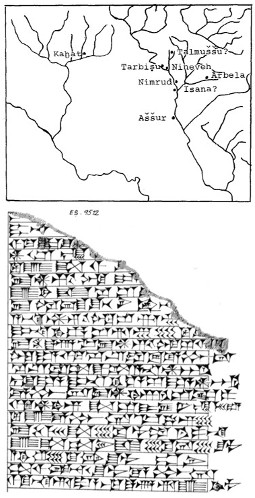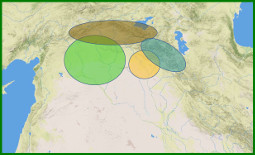Shalmaneser I
Browse the RIA 2 Corpus [/riao/ria2/pager/]
Quick links
Introduction
The inscriptions
Building projects
Index of geographic, ethnic and tribal names in the
inscriptions of Shalmaneser I

Text no. 9
Introduction
Shalmaneser I (actual spelling Salmānu-ašared, see Radner 2006-2008, and here [riao/ria5/shalmaneseriii/index.html]) was, according to the Assyrian King List [/riao/kinglists/assyriankinglist/assyriankinglist/index.html#MiddleAss] (AKL), the seventy-seventh king of Ashur, son and successor of Adad-nārari I and father and predecessor of Tukultī-Ninurta I, and reigned for thirty years.
His name might also be restored in a fragmentary exemplar (VAT 11931 [/riao/kinglists/synchronistickinglist/fragmentvat11931/index.html]) of the Synchronistic King List. A part from his own inscriptions, the Assyrian ruler is mentioned in various later inscriptions for different historical reasons, i.e. political episodes and building activities: Tukultī-Ninurta I, text no. 1 [/riao/ria2/Q005837/] iii 33 (rebellion of the Šubaru, Kašiyari, and Alzu); Aššur-rēša-iši I, text no. 1 [/riao/ria2/Q005899/]: 9 (Ištar Temple at Nineveh); Tiglath-pileser I, texts nos. 12 [/riao/ria2/Q005937/]: 27' (Ištar Temple at Nineveh), and 1008 [/riao/ria2/Q005963/]: 3' (Ištar Temple at Ashur); Aššurnaṣirpal II texts nos. 1 [/riao/ria4/Q004455/] I 102 (rebellion of Ḫulāiya - Kašiyari region) and 19 [/riao/ria4/Q004473/]: 93 (garrisoning the fortress of Tīdu), and
texts nos. 2 [/riao/ria4/Q004456/]: 52; 17 [/riao/ria4/Q004471/] v 1; 23 [/riao/ria4/Q004477/]: 15; 26 [/riao/ria4/Q004480/]: 46; 28 [/riao/ria4/Q004482/] v 1; 32 [/riao/ria4/Q004486/]: 7 (founder of the city Kalḫu); Esarhaddon texts nos. 57 [http://oracc.org/rinap/Q003286/] iii 30; 58 [/rinap/Q003287/] iii 10; 59 [http://oracc.org/rinap/Q003288/]
i 20; 60 [http://oracc.org/rinap/Q003289/] obv. 18' (Aššur Temple); Sîn-šarru-iškun text no. 10 [http://oracc.org/rinap/Q003871/]: 22 (Nabû Temple at Ashur).
The reign of Shalmaneser I is one of continuity between the two reigns of Adad-nārari I and Tukultī-Ninurta I, in a general tendency of growth for the Assyrian State. His major campaigns were led north- and north-eastwards, on one hand, against "rebellious" polities (although it is the first time we see mention of them) like Uruaṭri (see below), Arinu, and Muṣru, and against attacks from the still threatening Gutians, while, on the other hand, a campaign westward against the, possibly temporarily lost, reign of Ḫanigalbat (Mittani), was necessary in order to re-establish the rule that Adad-nārari had previously imposed.
The inscriptions
Shalmaneser I's royal inscriptions represent a digression in the development of the genre, in that their authors attempted to integrate the military detailed narrations, introduced by Shalmaneser's father Adad-nārāri I, with the traditional form of the inscriptions, embedding them within the epithet section (see, texts nos. 1 and 16). This produced some syntactic problems and few eccentricities for the reader – if not a "retrograde step," in the words of Grayson (RIMA 1 p. 180).Building projects

City interested by Shalmaneser I's building project, as survyed in text no. 16
The campaign against Mittani, which marks the end of that kingdom, assures to the Assyrians control over the western trade routes. It is probably because of such new flow of revenues that Shalmaneser I starts a large building activity that goes well beyond the scope recorded in his father's inscriptions. A building policy which will be pursued even to a greater extent by his son, Tukulti-Ninurta I.
In Ashur, Shalmaneser concentrates his attention especially to the
reconstruction of the Aššur Temple, or Eḫursagkurkurra, which had been
destroyed by a fire. The many texts recording this building undertaking
(nos. 1-5 and 20-22) give the
Distanzangaben, i.e. lapses of time between the writing king and those kings among
his predecessors, who founded and rebuilt the
temple. Ušpia [/riao/kinglists/assyriankinglist/index.html#Forefathers], Erišum [/riao/ria1/earlybeginnings/puzurashurdynasty/erishumi/index.html] I, and Samsī-Addu [/riao/riao1/oldassyrianperiod/samsiaddudynasty/samsiaddui/index.html] I, and a tragic report of the premise's destruction:
(text no. 1 [/riao/ria2/Q005789/]: 125-128)
Other projects in the capital included the works on the ziqqurrat (text nos. 16 and 23), the Ištar Temple (no. 6), "The Ninevite Goddess" Temple (no. 7), the temple or shrine of Šerua and Dagan (no. 8), the Palace (nos. 1010-11 and 28), a gate (no. 9) and a structure for the son of the king (no. 12). From Nineveh, the inscriptions give record of the works on the Ištar Temple (nos. 17-19, 24 and 29).
Of great interest, however, is the presence of a new kind of building inscription, which instead of recording the works on one single monument, presents an overview of different building projects located in several sites. This is text no. 16, and although its poor condition it clearly shows record of building projects from at least eight different cities: Ashur, Nineveh, Talmuššu, probably Arbela and Nimrud, and possibly Tarbiṣu, Kaḫat and Isana. With the exception of Kaḫat, all the cities mentioned in the text are located in central Assyria (see map).
Index of geographic, ethnic and tribal names in the inscriptions of Shalmaneser I
Most of geographical information from Shalmaneser I's inscriptions come from two very similar texts (so similar that their editions have been partly merged [/riao/ria2/Q005804/]). Both texts describe five major campaigns.
The campaign against Uruaṭri is said to start because of a rebellion,
although we do not possess any information on this mountainous region
prior to Shalmaneser I. The Assyrian king subjucates eight lands – Ḫimme
(see also Aššur-bēl-kala, texts nos. 1 [/riao/ria3/Q005982/]: 1'; 2 [/riao/ria3/Q005983/] iii 15'; 3 [/riao/ria3/Q005984/]: 3'; and 7 [/riao/ria3/Q005988/] ii 18;
and Tukulti-Ninurta I, text no. 1001 [/riao/ria2/Q005879/] r. 12'), Uatqun, Mašgun (or Bargun, see
also Aššur-bēl-kala, texts nos. 2 [/riao/ria3/Q005983/] iii 16' and 5 [/riao/ria3/Q005986/]: 12'), Salua (see also
Tiglath-pileser I text no. 4 [/riao/ria3/Q005929/]: 22 and 10 [/riao/ria3/Q005935/]: 26, and Adad-nērāri II texts
nos. 2 [/riao/ria3/Q006021/]: 25 and 4 [/riao/ria3/Q006023/]: 16'), Ḫalila, Luḫu (see also Tiglath-pileser I text
no. 1 [/riao/ria3/Q005926/] iv 10), Nilipaḫri (or Ṣ/Zallipaḫri), and Zingun - and destroys
fifty-one cities.
The
identification of Uruaṭri (var. Uruḫuatri, Uratri) is still debated (Gaspa 2014-16):
while M. Salvini identifies it as a different pronunciation of Urartu,
A. Fuchs locate it in the area east of the Tigris, between Upper and
Lower Zab, an identification that seems to find confirmation in one of
the very few later mentions of this land, in the inscriptions of
Adad-nērāri II:
(Adad-nērāri II text no. 2 [/riao/ria3/Q006021/]: 23-25)

From there, Shalmaneser I goes to subdue the
rebellion of the religious center of
Arina (see also Tiglath-pileser I text no. 1 [/riao/ria3/Q005926/] v 77 and Adad-nērāri II
text no. 2 [/riao/ria3/Q006021/]: 35). The city, which must have been located in the area
east of the coast of the Tigris, being mentioned between Uruaṭri and
Muṣri, must have had a special importance for the Assyrian king, who
takes the necessary space in the inscription to describe its
destruction and the sowing of the salt yelding kudimmu-plant
and the ritual of taking a heap of earth from the annihilated
settlement in order to put it in front of Ashur's walls for future memory.
The following campaign is against Muṣru, but here only a brief mention is given: "At that time I subdued all of the land Muṣri at the feet of Aššur, my lord." The land itself is to be located in an area bordering with central Assyria on the eastern side of the Tigris; note that Adad-nārāri I had praised his predecessor Aššur-uballiṭ as conqueror of Muṣri in his own inscriptions [/riao/ria2/Q005738/].
Then Shalmaneser needs to take care of Šattura II, king of Ḫanbigalbat, who rebelled against the rule imposed by Shalmaneser's father, Adad-nārāri I. This time the Mittanian king has been successful in bonding an alliance with the Hittites and the Aḫlamu-Arameans against Assyria, and in a rare case (for the Assyrian royal inscriptions) of description of a battle in the field the western allies are said to take the Assyrians by surprise and almost beat them: an even rarer description of actual peril on behalf of the Assyrian army. Shalmaneser I is, however, able to react and win the battle and therefore reestablishes his control over the same area (and same place names) formerly conquered by his father.
| The great gods gave me to rule from the city Taidu to the city Irridu, the city Eluḫat and Mount Kašiieri in its entirety, the fortress of the city Sudu, the fortress of the city Ḫarrānu, to the bank of the Euphrates. Adad-nārāri I, text no. 3 [/riao/ria2/Q005740/]: 37-42 | At that time I captured their cities (in the region) from Taʾidu to Irridu, all of Mount Kašiyari to the city Eluḫat, the fortress of Sūdu, the fortress of Ḫarrānu to Carchemish which is on the bank of the Euphrates. Shalmaneser I, text no. 1 [/riao/ria2/Q005789/]: 81-87 |
Finally, Shalmaneser had to deal, like his predecessors, with the threat represented by the Gutians (Qutū). Here, with a more heroic tone, the king annihilates the enemy alone, with only one third of his army with him.
Names are ordered according to graographical area (see the key-map)
| Name | Determinative* | Type | Modern Name | Reference |
|---|---|---|---|---|
| Central Assyria | ||||
| Arbela | URU | city | Erbil | Text no. 16 iii 11' |
| Aššur | 0, DINGIR | city | Qal'at Shirqat | IsaniText no. 1: 52, 106; 16 iii 14' |
| Isani | URU | city | Text no. 16 iii 16'. | |
| Talmuššu | URU | district of Ashur | Qal'at Shirqat | Text no. 16 iii 6', 9', 10' |
| Tarbiṣu (Tarbiṣi) | 0 | district of Ashur | Qal'at Shirqat | Text no. 10: 35; 13: 29, 30 |
| Ḫanigalbat (Mittani) and the West | ||||
| Carchemish | 0 | city | Ğarablūs, krkymyš | Text no. 1: 84 |
| Euphrates (Upper) | 0 | river | Text no. 1: 85 | |
| Ḫanigalbat | KUR | land | Text no. 1: 58, 60 | |
| Ḫarran | 0 | city | Ḥarran, Carrhae | Text no. 1: 84 |
| Hittite(s) | 0 | people | Text no. 1: 61, 78 | |
| Irridu | URU | city | Text no. 1: 11; 3 :35, 37, 47, 49, 50; 26: 4 (ex. 13) | |
| Kaḫat* | URU | city | Text no. 16 iii 15' | |
| Taidu (Taʾidu) | URU | royal city | Tall al-Ḥamīdīya | Text no. 1: 81 |
| Area of and around the Kašiyari range, upper Mesopotamia and north. Tigris | ||||
| Aḫlamû(-Aramaeans) | 0 | people | Text no. 1: 61, 79 | |
| Eluḫat | URU | city | Text no. 1: 83 | |
| Kašiyari | KUR | mountain range | Ṭūr ʿAbdīn | Text no. 1: 82 |
| Sūdu | 0 | fortress | Text no. 1: 83 | |
| Šubaru | 0, KUR | land, people | Text no. 4: 14; 17: 3; 18; 6; 1003: 2' | |
| Kutmuḫu (Katmuḫu) | KUR | land | Text no. 1: 99 | |
| Muṣru | KUR | land | Text no. 1: 54; 17: 3 | |
| Uruaṭri and the East of Tigris | ||||
| Arinu | URU | city | Text no. 1: 46 | |
| Ḫalila | KUR | land | Text no. 1: 34 | |
| Lūḫu | KUR | land | Text no. 1: 34 | |
| Lullumu (Lullubu) | 0 | people | Text no. 4: 14; 17: 3; 18; 6 | |
| MAŠgun (or BARgun) | KUR | land | Text no. 1: 33 | |
| Nilipaḫri (or ṢALlipaḫri or ZALlipaḫri) | KUR | land | Text no. 1: 35 | |
| Qutu (Gutians) | KUR, 0 | people | Text no. 1: 88; 4: 12; 17: 3; 18: 5 | |
| Salua | KUR | land | Text no. 1: 34 | |
| Uatqun | KUR | land | Text no. 1: 33 | |
| Uruaṭri | KUR | land | Text no. 1: 27, 40, 98 | |
| Zingun | KUR | land | Text no. 1: 36 | |
| * 0 = no det.; [...] = erased | ||||
Bibliography
Browse the RIAo Corpus [/riao/pager/]